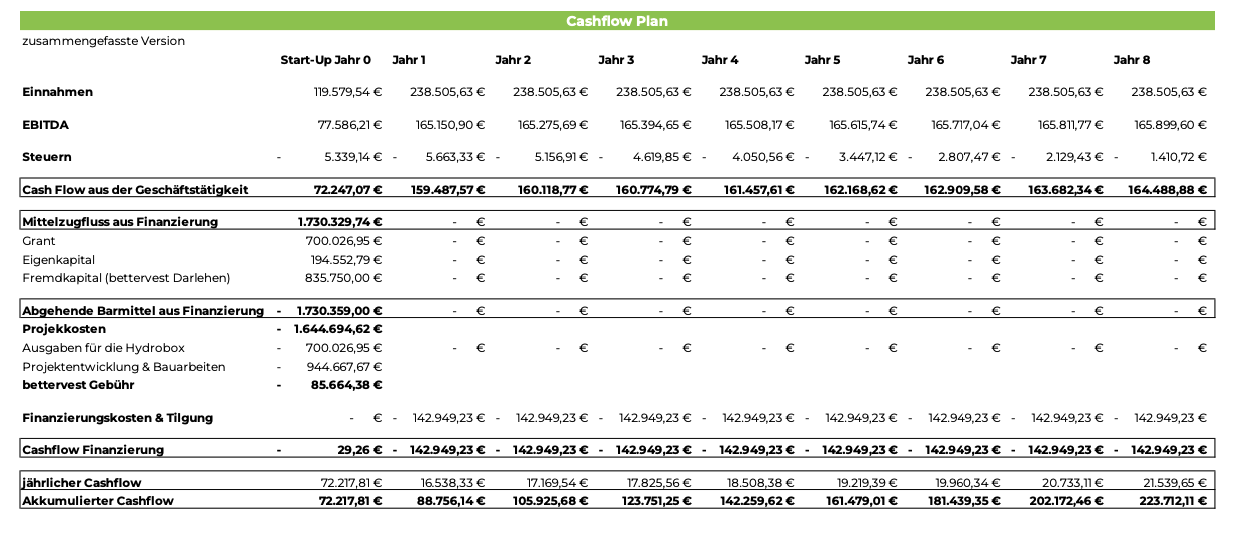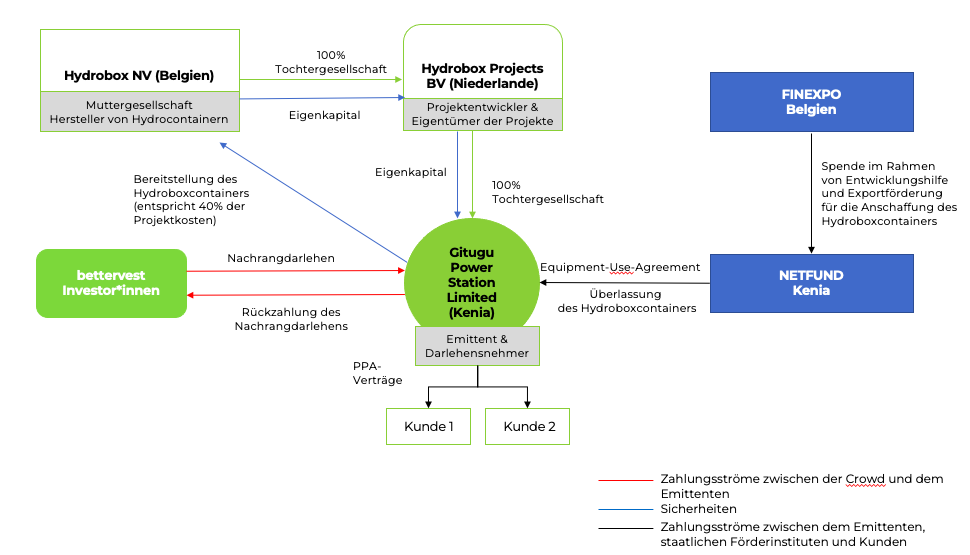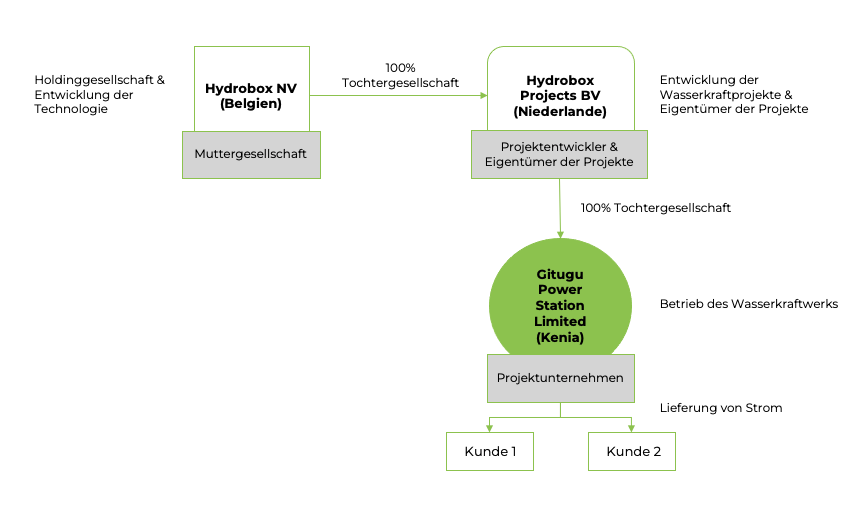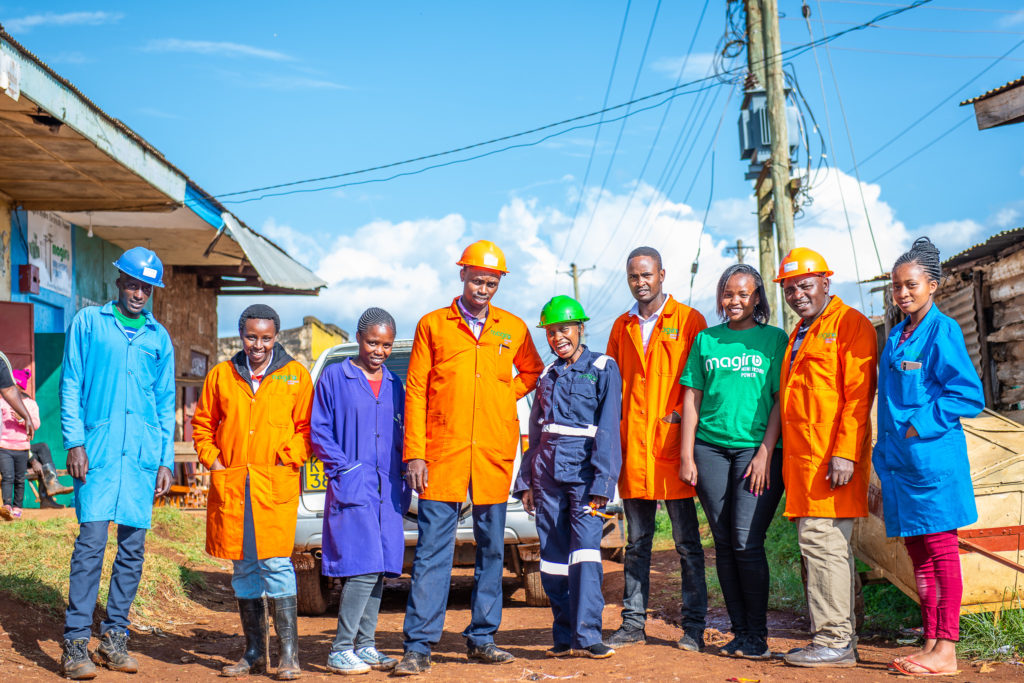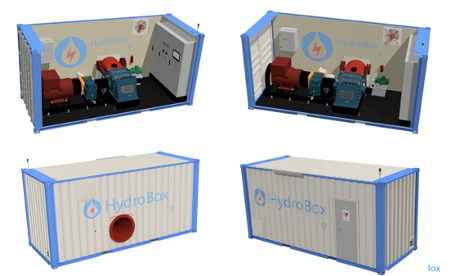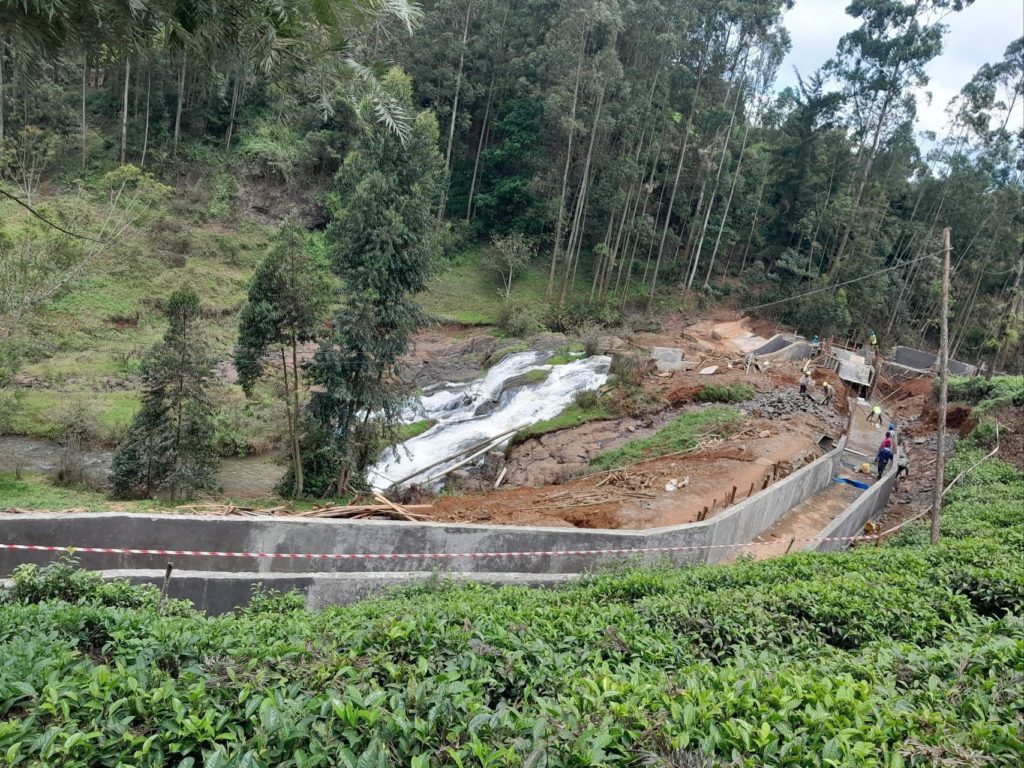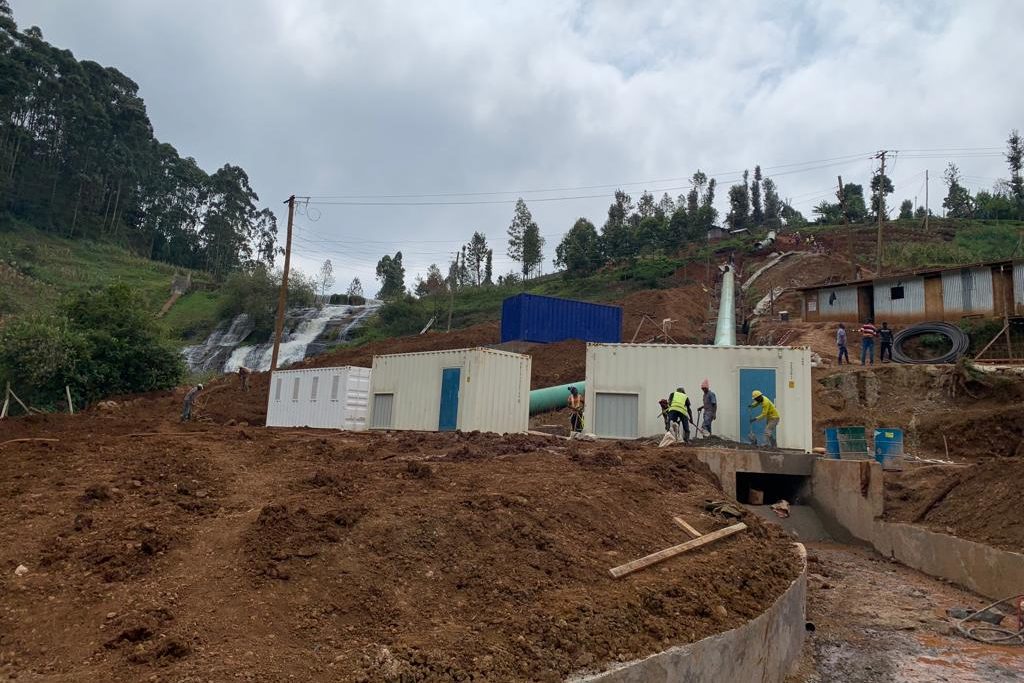Support the production of clean electricity from environmentally friendly, innovative river hydropower for businesses and households in Kenya, avoiding 1,078 tonnes of CO2 per year!
Video from March 2022. For subtitles, please press the CC button in the lower right-hand corner of the screen.
The acquisition of this investment is associated with considerable risks and may lead to the complete loss of the invested assets.
UN Sustainable Development Goals

The investment at a glance
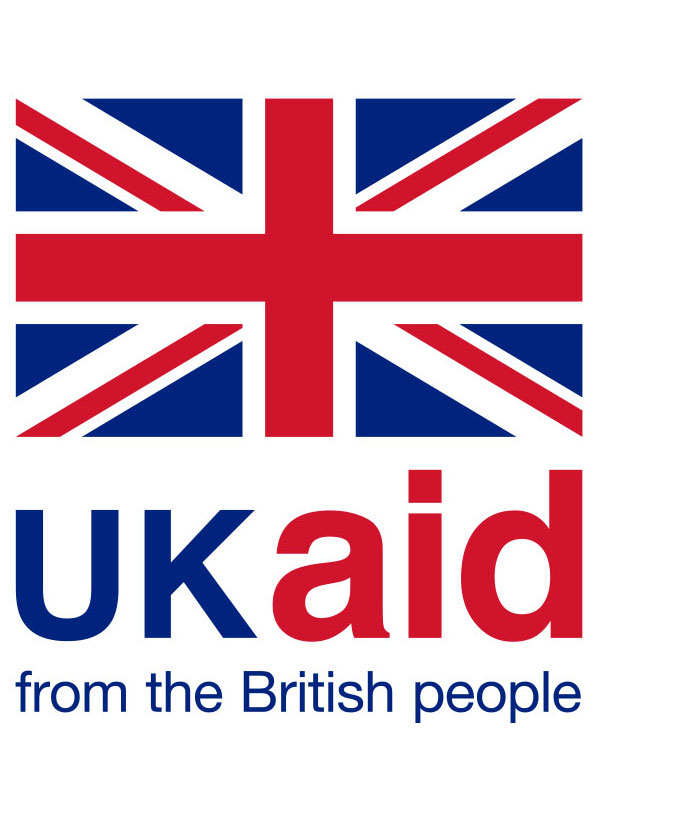
This project is supported by UK Aid through Energy 4 Impact’s Crowd Power programme.
This crowdlending campaign is the second funding round of the project “Clean Power from Container Hydropower Plant for Businesses in Kenya – Hydrobox”, which aims to collect a total of EUR 835,750 through the bettervest crowd. The first funding raised EUR 616,350.
Project intent
The Belgian company Hydrobox NV (Hydrobox), through its Kenyan subsidiary Gitugu Power Station Limited, will use the loan to finance the construction of an environmentally friendly run-of-river (flowing water) hydropower plant with a total capacity of 533 kilowatts (kW) in Murang'a County, Kenya. The special feature of the containerised plant is that it is standardised and "smart". Standardisation allows costs and production time to be reduced, and the "smart" features enable remote operation and monitoring, an advantage in rural areas. Hydrobox is a developer and producer of standardised, innovative container plants. Most of the green power generated by the container is sold to Kenyan companies in the food and telecommunications industries. The remaining portion goes to essential customers such as hospitals, schools and households. This mix of customers is critical because of grid-balancing properties and these diverse consumers require power at different times. Second, high-consuming large customers enable Hydrobox to charge low-income households, schools and hospitals an affordable rate while still generating enough revenue to make the project an attractive investment opportunity. This project from Hydrobox will receive support in the form of subsidies from the Belgian government agency FINEXPO and from the Kenyan government state agency NETFUND.
Sustainable & social impact
By switching to sustainable hydropower, Hydrobox's customers receive a reliable and stable supply of cheaper and cleaner electricity. The Hydrobox solution is vital for rural businesses, hospitals, and schools operating in areas where there is no stable power supply from the national grid. This can greatly boost the economic performance of local businesses, as they will no longer be affected by power outages and will not have to rely on expensive diesel generators. The project will also enable 1,000 end-users (households) to enjoy a more affordable and reliable electricity supply, thereby raising their standard of living. In addition, the project is expected to create 10 new jobs and another 25 indirect jobs.
Climate protection
The implementation of the project and the installation of the hydropower plant will save approximately 1,080 tons of CO2 annually. The micro-generating facility relies on the run-of-river principle to generate electricity, which has a very small environmental footprint compared to large traditional hydropower plants with dams and reservoirs. The run-of-river power plant uses only a portion of the river water and does not require an upstream dam. Large reservoirs often have negative impacts on forests, wildlife habitats, and agricultural land. The company conducted an environmental and social impact assessment at the start of the project and has a system in place for ongoing monitoring of environmental and social impacts. The project will be subject to annual environmental audits .
Early bird bonus
All investors who invest up to and including 11.11.2022 will receive an early bird bonus of 1%. The interest rate thus increases to a total of 7% over the duration of the loan.
Podcast by Hydrobox
Hydrobox has launched its own podcast series to share its passion for Africa, social entrepreneurship and renewable energy as levers for a better world. Together we are stronger - Tuko Pamoja.
Risk reduction measures
1) Low level of debt financing a) Subsidies The grant contribution from the Belgian and Kenyan authorities, in the form of the transfer of the Hydrobox container power plant, amounts to USD 790,000 and covers 40% of the total financing costs. b) Equity capital In addition to the public funding, the project company will receive equity funding from the Belgian parent company in the amount of USD 220,000 or 11% of the total project cost. The grant and equity will reduce the project's level of debt financing to USD 944,000 or 48% of total costs. 2) Financially strong parent company The parent company Hydrobox NV in Belgium, a company with a comfortable equity cushion, confirmed its intention to support the project company Gitugu Power Station Limited (the issuer) at any time with additional financial resources, e.g. in the event of payment delays by customers. In further support for such an eventuality, the parent company has obtained the rights to secure the Hydrobox Container, originally pledged by NETFUND to Gitugu Power Station, as additional collateral (see financing structure below). 3) Insurance coverage The project company, Gitugu Power Station Limited, has taken out comprehensive insurance cover for the containerised hydropower plant, which, in addition to the usual risks (fire protection, theft, etc.), also covers claims for damages and the loss of income in the event of damage to machinery.
Established, sustainable company
Hydrobox NV was founded in 2018 in Brussels, Belgium. The company develops and manufactures innovative, standardised containerised hydropower plants and is dedicated to providing reliable, sustainable and affordable access to energy, especially in rural areas of Kenya. Through its local subsidiaries, Hydrobox currently operates three hydropower plants with a total capacity of 125 kW in Murang'a County, Kenya, providing access to electricity for over 3,000 end users. In addition to the current project, Hydrobox has seven other projects in development that will add an additional 3.5 megawatts to its existing operations over the next 24 months. The company is a partnership between a Belgian and Kenyan entrepreneur and is deeply embedded in the local community, where it works with other organisations to bring about positive change. The company maintains good relationships with government stakeholders and since 2018 has had a strategic partnership with NETFUND (National Environment Trust Fund), an agency of the Ministry of Environment and Forestry, to pilot innovative energy projects in the country. In addition, Hydrobox is supported by the Belgian government agency FINEXPO, which is working with NETFUND to financially support this project's container hydropower plant. Hydrobox received the 2019 EDF Pulse Africa Award for the most innovative off-grid power generation model. In addition, Hydrobox was awarded the 2019 Most Innovative Company Award by Jungle Bells (Euronext) for its innovation in providing scalable sustainable energy solutions. In 2020, the company was included in the list of 100 Top Startups (SET100) in the Start Up Energy Transition Awards and was awarded the "Efficient Solution" label by the Solar Impulse Foundation.
Project description
Kenya is one of the fastest developing countries and a major hub in East Africa. Kenya recorded economic growth averaging 5.7% in 2019 and was forecast to grow 5% in 2021 despite the Corona pandemic. Nevertheless, Kenya’s energy problem is hampering its further development: nearly 40% of the rural population still lacks access to energy, and those who are connected to the grid complain of poor power reliability and high electricity prices. This is also felt by businesses, which have to contend with costly production losses due to power outages.
Small and medium-sized enterprises are the heart of the Kenyan economy and provide 80% of the new jobs created each year, thus ensuring stability and growth in the country.
This is where Belgian-Kenyan company Hydrobox NV (Hydrobox) comes in, with a mission to provide reliable, sustainable and affordable access to energy. Hydrobox relies on environmentally friendly river hydropower, which is more efficient than many other renewable energy sources because it is based on a resource that is available 24/7 (running water) and has a longer lifespan than, for example, inverters and battery systems. Despite the higher initial investment, hydropower generates electricity at a very low cost per kWh.
The company has developed a standardised and smart containerised hydropower plant that is deployed in a decentralised manner on rivers and can be operated and monitored remotely. In addition, the power plants rely on the “run-of-river” principle to generate electricity, which does not require a dam and minimises the impact on nature.
Through this crowdfunding campaign, Hydrobox aims to finance the project development and construction of a containerised hydropower plant with a total capacity of 533 kW in Murang’a County, Kenya. Hydrobox will sell the green power to two agricultural enterprises, two telecommunication companies, ten schools, two hospitals, and 1,000 end users who will benefit from a stable, low-carbon electricity supply as well as cost savings. The project is fully planned and construction is nearly complete. It is expected to begin generating electricity in November 2022. This is the second funding round of the project. The first funding already collected EUR 616,350 from March to September 2022. In this second funding, the remaining amount will be financed. The project is the result of a collaboration between Hydrobox, NETFUND and the University of Brussels. In 2018, these parties signed a Memorandum of Understanding to collaborate on the application of Internet-of-Things technology in distributed energy projects in Kenya. This collaboration led to the joint development of a SMART hydropower plant in Kenya based on the concept of a standardised, containerised hydropower plant. Furthermore, this project from Hydrobox will receive monetary support from both the Belgian government agency FINEXPO and from the Kenyan government state agency NETFUND.
Through its business model, Hydrobox actively contributes to four of the UN’s sustainable development goals (“SDG“):
Through the installation of the hydropower plants, Hydrobox’s customers receive clean, renewable electricity, which is a cost-effective alternative compared to the Kenyan electricity grid or diesel generators (Goal 7.2).
Hydrobox’s customers are small and medium enterprises operating in various sectors such as agriculture, more specifically tea cultivation, or IT. Expensive electricity, frequent power outages, and poor power quality are recurring problems. Thus, a constant and reliable source of electricity that is available 24/7 can have an indirect impact on the economic sustainable growth of businesses (Objective 8.1).
Hydrobox’s containerised hydropower plants can be deployed in a decentralised manner, making them particularly beneficial in rural areas where infrastructure is weak. The innovative plant, which is equipped with smart sensors, can also be operated and monitored remotely. The smart system also enables “predictive maintenance,” which can reduce costs and increase the life of the plant (Objective 9.4).
Hydrobox’s business model addresses climate change (Goal 13), as the hydropower plants replace diesel generators and grid electricity, and provide a significant reduction in CO2.
By switching to green hydroelectric power, Hydrobox’s customers can increase their environmental impact by reducing their CO2 emissions. The container hydropower plant generates approximately 2,160,000 kWh of electricity annually, resulting in CO2 savings of 1,077.8 tons per year.
The average CO2 emissions per kWh of electricity generated from the general energy supply mix of the Kenya Power and Lighting Company, the public grid operator in Kenya, were used as the basis for the calculation. This rate is currently 499 g/kWh. Over the life of the project, this results in CO2 savings of 8,622.7 metric tons, and over the life of the hydropower plant of approximately 25 years, 26,945 metric tons of CO2 can be avoided.
The investment risks associated with the subordinated loan are described in detail in the VIB under item 5 and in the risk notes. With a view to assessing and limiting the risks for investors, the issuer draws attention to the following special features in the design of the project:
1) Low debt financing ratio
a) Subsidies
The contribution from the Belgian and Kenyan authorities in the form of the Hydrobox container power plant amounts to USD 790,000 and covers 40% of the total financing costs.
b) Own funds
In addition to the public funding, the project company will receive equity funding from the Belgian parent company in the amount of USD 220,000 or 11% of the total project cost. The grant and equity will reduce the project’s level of debt financing to USD 944,000 or 48% of total costs.
2) Financially strong parent company in Belgium
The parent company Hydrobox NV in Belgium, a company with a comfortable equity cushion, has declared in discussions with bettervest its firm intention to support the project company Gitugu Power Station Limited (the issuer) at any time with additional financial resources, e.g. in the event of payment delays by customers. In order to be in an even stronger financial position for such an eventuality, the parent company has obtained the rights to secure the Hydrobox Container, originally pledged by NETFUND to Gitugu Power Station, as additional collateral (see financing structure below).
3) Insurance coverage
The project company has taken out comprehensive insurance cover for the container hydropower plant with the South African insurance company Sanlam, covering not only the usual risks (fire protection, theft, etc.) but also claims for damages and loss of earnings in the event of machinery damage.
Investment needs
The total project cost is EUR 1.65 million and includes the construction of the container hydropower plant, project development costs, civil works and grid costs for electricity distribution. The project is partly financed by a grant and equity participation from Hydrobox.
The bettervest crowdfunding campaign will finance the remaining EUR 835,750 (including fees). The loan will cover the cost of construction works (survey, excavation, construction of the intake, forebay and penstock) and electrical works (step-up transformer, distribution boxes, power lines). The first funding raised EUR 616,350 via the bettervest crowd with the remaining amount now to be financed.
The term of the loan is 8 years with an annual interest rate of 6% for the crowd-investors. Repayment takes place once a year and includes repayment and interest (annuity repayment). Investors who invest in the project within the first four weeks receive an additional early bird bonus of 1% (7% in total over the loan duration). The funding threshold for this project is EUR 50,000. If only the threshold is reached, the issuer will cover the difference by additional required debt capital from its parent company Hydrobox BV and carry out the project .
Repayment
Loan repayments will be serviced from funds generated from the sale of electricity through executed Power Purchase Agreements (PPAs) with customers.
The power plant will supply electricity to two agricultural enterprises, two telecommunication companies, ten schools, two hospitals and 1,000 end users through a mini-grid. The largest customers are presented below:
Kiriti Tea Factory is a tea factory developed by and for local tea farmers. It is a group of passionate tea farmers in the foothills of the Aberdare Mountains in central Kenya who have extensive experience in the tea sector. With hundreds of affiliated tea farmers and over 600 hectares of mature highland tea, the factory is successfully on its way to revolutionising the Kenyan tea industry.
BRCK is a rural internet solutions provider that aims to connect people and things by connecting individuals and businesses online and helping them take full advantage of internet access. The BRCK solution enables businesses to advertise or collect data, offers WiFi connectivity to rural communities, and provides a platform where customers can store and share their digital content.
Safaricom is Kenya’s leading mobile telecommunications company. Safaricom provides 4G Internet, now available in over 30 counties in Kenya. Safaricom has already deployed 635 sites, approaching 1,000 4G stations. Safaricom needs reliable power for its transmission towers in the region where Hydrobox operates. The company has also set a goal of sourcing electricity from 100% renewable sources by 2030.
The ten rural schools and two rural hospitals have smaller needs (5-20 kW) but are essential: access to Hydrobox’s energy allows them to provide uninterruptible service, reduce operating costs, and make the transition to renewable energy. The 1,000 household end-users are customers for whom the national grid is not accessible, not reliable enough or not affordable due to high connection fees.
Hydropower represents the largest renewable energy source in the world . In 2020, hydropower provided one-sixth of the world’s electricity generation, making it the third largest source of electricity after coal and natural gas.
How does hydropower work?
A hydropower plant harnesses the flow of running water, which is why they are often built on rivers. The German Federal Ministry of Economic Affairs and Climate Action explains the principle as follows: “The kinetic and potential energy of a water flow is converted by a turbine wheel into mechanical rotational energy that can be used to drive machines or generators.” Two main parameters determine the amount of electricity generated: the water column, which is the difference in elevation between the point of water extraction and the turbine, and the flow rate, which is the amount of water flowing through the river, measured in m3/s.
What are the different types of hydropower plants?
One can classify hydropower plants according to different criteria. A basic division can be made by configuration: a plant with a dam and reservoir or without. Hydropower plants with a dam and a reservoir can store water for short or long periods to meet peak demand. Run-of-river hydropower plants provide smaller amounts of electricity and are usually designed to operate in a river without interfering with its flow. For this reason, small-scale hydropower is considered a more environmentally friendly option because it minimises interference with nature.
Advantages of hydropower
In areas where there is a suitable river, small-scale hydropower is a viable alternative to solar and wind power because it is available 24/7. This allows hydropower plants to provide continuous power without the need to store electricity in batteries, which is costly and often technically impossible for industrial users such as factories or power-intensive IT applications. Continuous hydropower production also stabilises national power grids with baseload production that balances intermittent power sources such as solar and wind, ensuring a stable national grid.
Hydrobox’s containerised hydropower plant – Decentralised energy with minimal environmental impact
Hydrobox offers an innovative, containerised hydropower plant. It is delivered in two standard 20-foot containers for easy handling and transport to the site. The plant is characterised by a high degree of standardisation: the container is fully equipped and prefabricated in Belgium, simplifying on-site installation. The plant consists of two cross-flow turbines and two three-phase synchronous generators for single and parallel operation. It is both grid-tied and off-grid, and equipped with smart sensors and remote management features that provide the following benefits:
- Remote monitoring: water levels, temperatures, turbine speed, turbine valve position, electrical output parameters.
- Automatic water level control: hydraulic control of turbine valves and hydraulic power units depending on the current water level
- Automatic control system with touch screen for on-site control of the power plant, voltage regulation and synchronisation with the grid
- Remote control possibility: start & stop operatons; turbine valve opening & closing; switching of the operating mode (manual/automatic)
- Daily reports and alarm functions
The container hydropower plant is a small, compact plant in container form, which can be installed decentralised near the consumers (local power production for local consumption). This has the advantage of avoiding significant losses in the transmission and distribution of electricity.
Furthermore, Hydrobox attaches great importance to having the lowest possible impact on the environment. The plant’s run-of-river design preserves the natural course of the river and is not affected by the construction of a dam, which would disturb the environment. Only a part of the river is diverted for power generation (which ensures sufficient ecological flow) and flows back into the river a few hundred meters later (no water extraction). A fine-mesh trash rack prevents fish from entering the intake and becoming entangled in the turbine.
A detailed environmental and social impact assessment was conducted at the start of the project, the company has a system in place to monitor environmental and social impacts, and the project is audited annually by the Ministry of Environment. This ensures a minimal environmental footprint.

The containerised hydropower plant combines many advantages over other traditional hydropower plants: standardisation and smart design reduces time and costs; the run-of-river design reduces the ecological impact; the generating units are easier to scale than single household systems; and the container is easier to implement than large and complex infrastructure projects. In addition, the container hydropower plants have long lifetimes (up to 30 years).
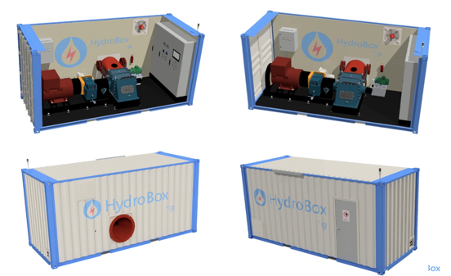
The second webinar on Hydrobox’s project took place on 10 November 2022 at 6pm. Thomas Poelmans, founder and CEO, presented the project and the current construction progress and answered the questions of the participants. You can watch the recording here.
On 20 April 2022 at 6 pm the webinar on Hydrobox’s project took place. Founder and CEO Thomas Poelmans presented his company and the project and answered the questions of the investors. You can watch the recording of the webinar here .
Over the past few weeks, we at Hydrobox have been working on a podcast series with Raf Stevens and Tito Monako.
We developed this initiative because our community of investors and supporters keeps growing, and because our existing investors keep telling us that who we are and what we stand for is the main reason why they invest in us.
Many stories have been told about the African continent – some positive, but also many not so positive.
With this podcast, we want to share our passion and optimism about Africa, social entrepreneurship, and renewable energy as levers to improve the world.
We hope these stories can change some people’s views and inspire others. Together we are stronger – Tuko Pamoja.
Spotify link: https://open.spotify.com/show/1uZNlGoyNqxIdcllYxusbF?si=CnT3b6XZQoWFYG3hbxQ_5w
Also accessible via: https://rss.com/podcasts/tuko-pamoja-hydrobox-podcast/
15.09.2022 – More project news about the current construction status
Since the last update at the end of June, a lot has happened: the Hydrobox containers have been successfully erected and the construction work is almost complete. The cement now needs to dry for a few more weeks so that the commissioning of the container hydro plant can take place in November.
Through your support, Hydrobox can implement the project “Clean Power from Container Hydropower Plant in Kenya”. As a result, Hydrobox’s customers (businesses and households in Kenya) will receive environmentally friendly electricity from river hydropower and benefit from lower tariffs and a reliable and stable power supply.
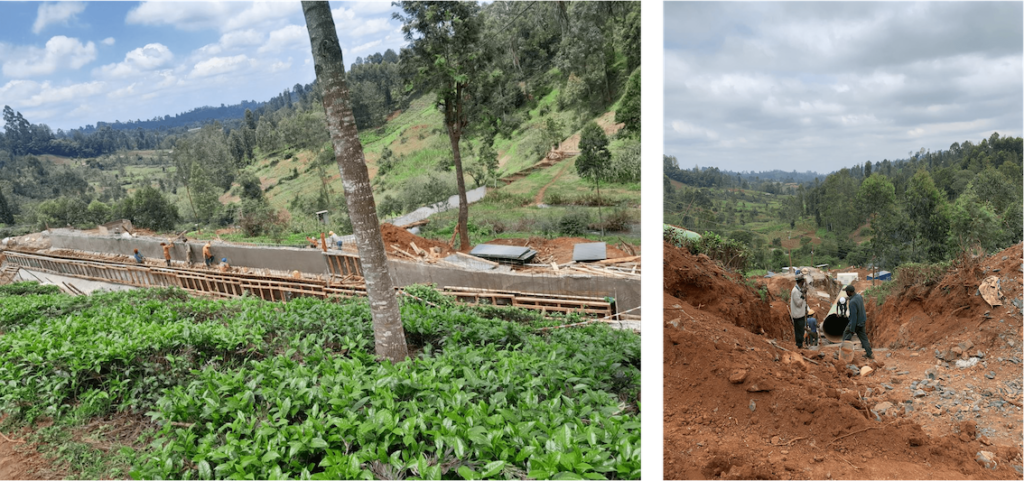
The detailed status report from September 2022 can be found here.
24.06.2022 – Successful construction process and first customer contracts
“The expansion of the Gitugu power plant is well underway! In the last few weeks, construction work was carried out on the power plant foundation. The contractors have completed the power plant area. The weir (a barrier to raise the water level) through which some of the river water will be directed to the power plant, is also almost completed. In the coming weeks, the weir, intake pipes, de-silting basin and forebay will be completed. We expect construction to be completed by the end of July 2022.
In the meantime, the hydroelectric components have been completed and are now being transported to their destination. The power plant is scheduled to be installed in July. The penstock, the metal pipe through which the water will flow, has also been completed and is now being transported to its final location. We expect the Gitugu power plant to be operational by mid-September.
We are now finalising the contracts with our customers. One of the main customers, the Kiriti tea factory, is one of the first to be connected to the grid. The schools, businesses and household customers will be connected soon after. The grid lines are currently being developed and laid so that we can provide electricity to our first customer in September this year.”
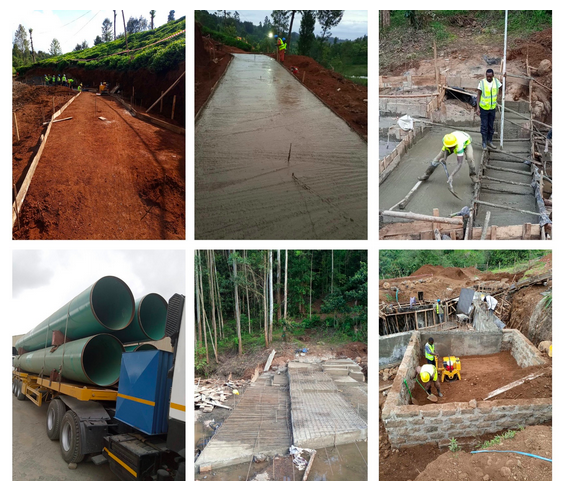
The detailed June 2022 status report can be found here.
13.05.2022 – Project News from Hydrobox: Work commences on installation of container hydropower plant in Kenya
The Gitugu 1 containerised hydropower plant is expected to have a final capacity of 533 kW. The construction of the Gitugu 1 mini hydropower plant has been awarded to Afribright Limited for the design and construction. The scope of work includes a) construction of access roads and drainage, b) construction of intake, detour weir, intake channel, desilting basin and hydrobox plates, and c) installation of penstock.
Several activities have been completed since March: contractual requirements arranged (e.g., insurance cover obtained, preliminary design); the establishment of a site building, including the site office; and construction of the site access road. In addition, work commenced on the river detour, intake and weir ditch, and water intake. Excavation work also commenced for the intake channel, de-silting basin, forebay and penstock.
Thomas Poelmans, founder and CEO of Hydrobox was first on site during a visit and has captured some impressions for you:
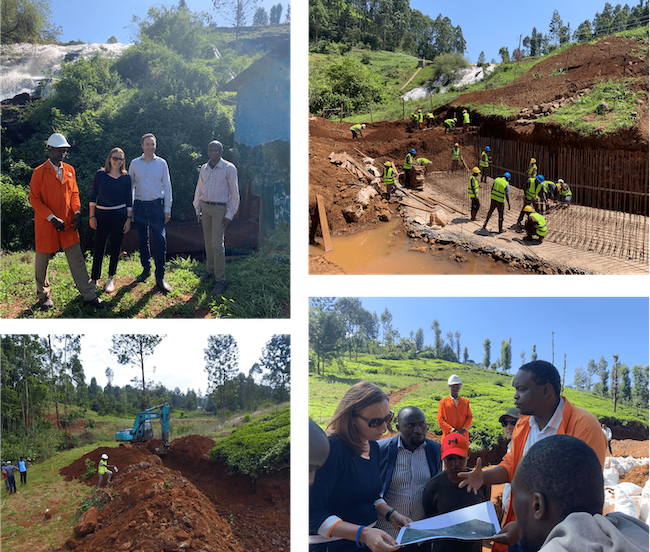
You can find the detailed status report from May 2022 here.
Our mission is to create positive impact by empowering people and transforming communities through sustainable electricity. We do this by electrifying all facets of a community through an innovative business model and technology, ensuring that our customers benefit from reliable, affordable and green electricity. This in turn helps them grow their business and improve their standard of living.
Supporting our campaign with bettervest helps us empower businesses and households in Kenya, transition the country to green power and achieve a positive financial return. This is an investment in people, the planet and profit.
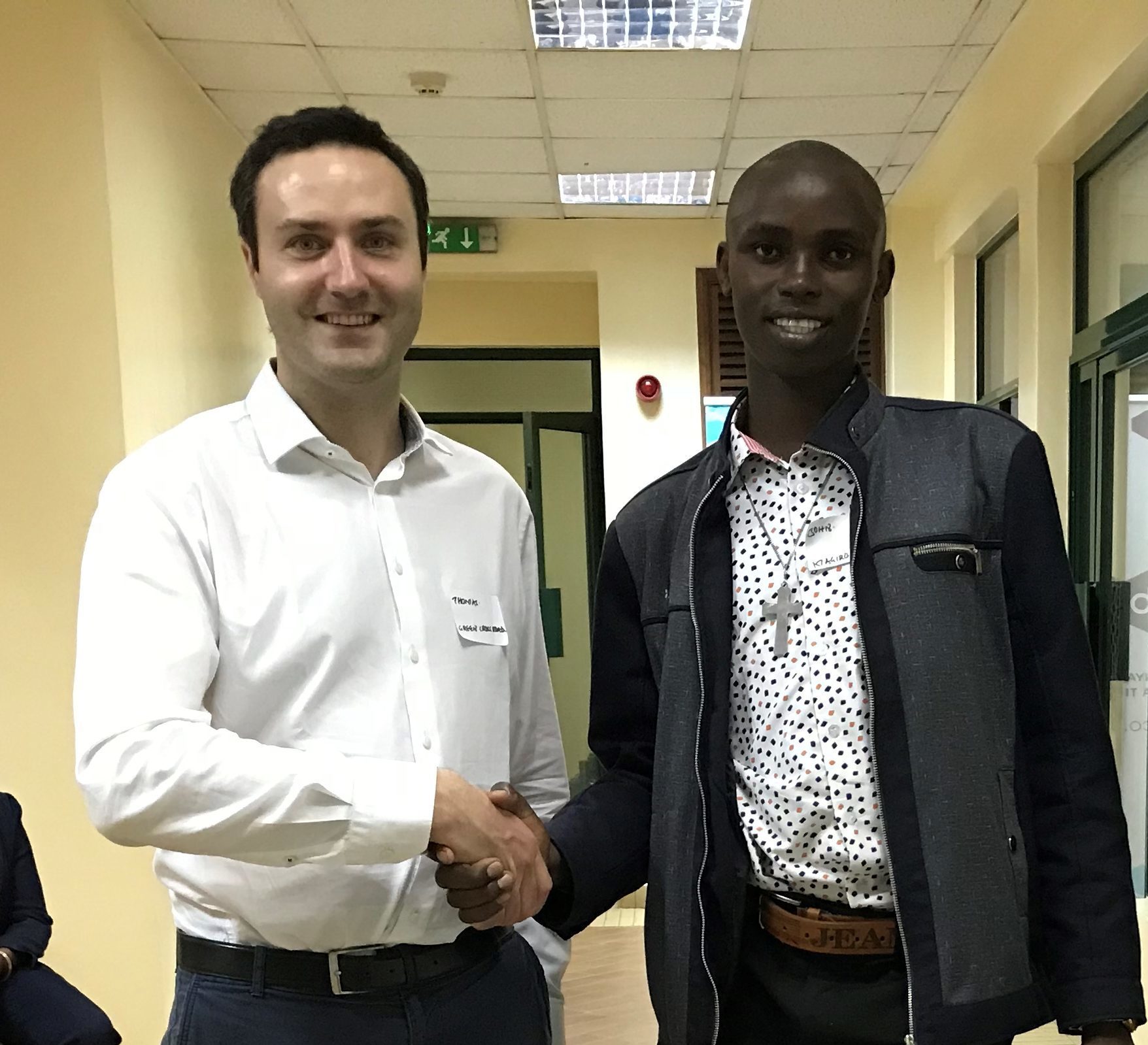
The Borrower and Country Profile

Gitugu Power Station Limited
Miotoni Terraces
No. 7 Warai Road
Nairobi, Kenya
Hydrobox NV
Ulensstraat 86, Box 6 Makani 1080 Sint-Jans-Molenbeek Belgium
Contact:
+32 498 610833 info@hydrobox.africa
www.hydrobox.africa
Thomas Poelmans, founder and managing director of Hydrobox, was formerly head of Deloitte’s Africa consulting practice in Belgium, where he was responsible for a service line that provided financial audits, due diligence, fraud investigations and project management support across Africa. After his time at Deloitte, he started working as an entrepreneur in Africa.
In 2012, he was one of the initiators of WorldLoop, where he supported the establishment of 15 e-waste recycling companies across Africa. In 2015, he co-founded NAMé Recycling, a plastic recycling company operating in Cameroon and Gabon. In 2018, he founded Hydrobox.
John Magiro, Hydrobox’s technical director, grew up in a small village in Murang’a Kenya, about 3 hours’ drive from the capital Nairobi. In his childhood, no one in his community had electricity. The nearest electricity pole was 15 km away. After seeing his mother struggle, he decided to build his first micro hydroelectric power plant using everyday objects. His talent was quickly noticed, so he was able to expand and professionalise the technology by building a weir to channel water to a turbine and generate electricity.
John is the winner of the Switch Africa Green – Seed Award 2016, East Africa Hub Grant 2017, WWF Africa Youth Award 2017, EDF Pulse Africa Award (2019) and Business Daily Top 40 under 40 Award (2020).

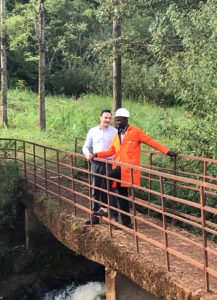
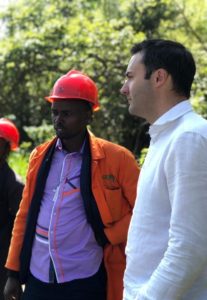
Gitugu Power Station Limited: Issuer, Borrower and Project Company
The project company Gitugu Power Station Limited is based in Kenya and acts as the issuer and borrower in this project. At the same time, Gitugu Power Station Limited is the project company that operates the hydropower plant. Gitugu Power Station Limited
Hydrobox Projects BV: project developer and shareholder of Gitugu Power Station Limited
Hydrobox Projects BV was established in 2019 and is based in the Netherlands. It is a shareholder in the local project companies such as the issuer Gitugu Power Station Limited (100% parent company) and is responsible for the project development and construction of the plants.
Hydrobox NV: Holding company and manufacturer of the containerised hydropower plants
Hydrobox NV is a holding company established in Belgium in 2018. It is the parent company of Hydrobox Projects BV (100% shareholder). In addition, Hydrobox NV is the manufacturer of the container hydropower plants.
National Environment Trust Fund (NETFUND): Cooperation partner
The National Environment Trust Fund (NETFUND) is a Kenyan government agency under the Ministry of Environment and Forestry. NETFUND acts as a development partner in this project: NETFUND has supported Hydrobox in the development of the project and is the legal owner of the container hydropower plant through a donation from the Belgian government. NETFUND provides Gitugu Power Station Limited with the use of the plant and equipment through a 20-year agreement. This agreement includes the right to use the asset of the plant as collateral or pledge for debt financing purposes.
FINEXPO: Cooperation partner and grant provider
FINEXPO is a Belgian inter-ministerial advisory committee led by the Financial Support for Exports Directorate of the Federal Public Service for Foreign Affairs, Foreign Trade and Development Cooperation and by the International and European Financial Affairs Administration of the Federal Public Service Finance. FINEXPO has supported NETFUND with a grant of €700,000 for the purchase of the hydroelectric container from Hydrobox NV.
When making investment decisions, it is advisable to find out in advance about the project location, especially the country in which the project will be implemented. To get an overview, the following indicators are a helpful starting point for independent research. The information was retrieved from the relevant data sources in March 2022 and is published without guarantee.
| INDIKATOR | BEWERTUNG KENIA |
|---|---|
| Euler Hermes Ranking | Euler Hermes hat das Risiko der Nicht-Zahlung von kenianischen Unternehmen mit „sensitive risk“ bewertet und auf einer Skala von AA bis D mit C gerated (Quellen: Euler Hermes Country Risk Map) |
| OECD Klassifizierung | Die OECD klassifiziert das allgemeine Länderrisiko Kenias auf einer Skala von 0 (geringes Risiko) bis 7 (hohes Risiko) mit 6 (Quellen: OECD Country Risk Classification und OECD Ranking 2022). |
| Korruptionsindex (Transparency International) | Der Korruptionsindex, der von Transparency International veröffentlicht wird und auf einer Basis von 0 (hohes Maß an Korruption) – 100 (keine wahrgenommene Korruption) bemessen wird, liegt in Kenia bei 30 (Quelle: Transparency International 2021). |
| Commercial Bank Prime Lending Rate | Die Commercial Bank Prime Lending Rate zeigt auf, welchen Durchschnitt an annualisierten Zinsraten lokale Geschäftsbanken ihren kreditwürdigsten Kunden für neue Kredite in der Landeswährung berechnen. Bei Kenia lag die Commercial Bank Prime Lending Rate im Januar 2022 bei 12,12% (Quelle: Trading Economics 2022). |
| Kreditwürdigkeit (Moody’s) | Moody’s hat die Kreditwürdigkeit von kenianischen Staatsanleihen auf einer Skala von AAA bis D mit B2 bewertet und somit als spekulativ eingestuft (Quelle: Trading Economics 2022) |
| Devisenmarkt (Bundesbank) | In den letzten fünf Jahren ist der Devisenpreis für den Euro in Kenia gestiegen, vor fünf Jahren lag der Preis bei 110,56 Kenia-Shilling, vor einem Jahr bei 128,60 und heute liegt der Preis bei 127,65 Kenia-Shilling (Quelle: Bundesbank 2022). |
Key figures
| Borrower | Gitugu Power Station Limited |
| Type of Investment | Subordinated Loan |
| Funding volume | EUR 835,750 |
| Term | 8 years |
| Interest | 6.0% p.a. (7.0% p.a. for all investments within the first 4 weeks) |
| Repayment of loan and interest | annuity |

